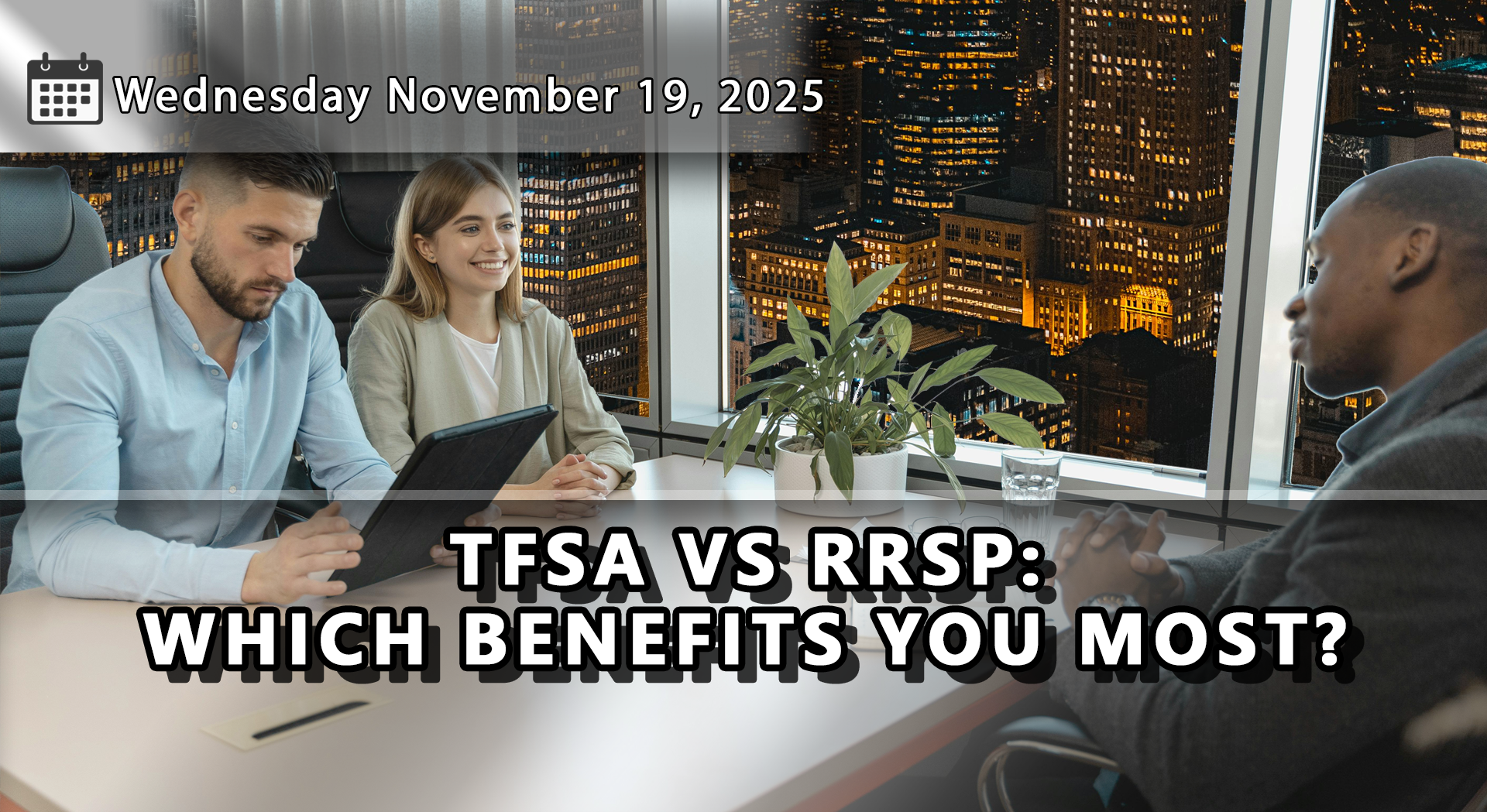TFSA vs RRSP: Which Is The Right One For You?
Wednesday, November 19, 2025

When it comes to saving and investing, choosing between TFSA and RRSP is a common scenario for many Canadians. The truth is, both the Tax-Free Savings Account (TFSA) and Registered Retirement Savings Plan (RRSP) offer tax advantages and are great investment vehicles.

To make your decision-making easier, below you can find a comprehensive guide on how each account works, their unique benefits, and how they can fit into your financial goals.
TFSA vs RRSP: The basics

Both Tax-Free Savings Accounts (TFSAs) and Registered Retirement Savings Plans (RRSPs) are considered registered accounts, which are specially created accounts that are given unique tax advantages by the Canada Revenue Agency (CRA). Your investment returns, whether interest, capital, or dividends, can be tax-sheltered, i.e., not subject to tax or tax-deferred until withdrawal.
Other types of registered accounts in Canada include the Registered Retirement Income Fund (RRIF), Registered Education Savings Plan (RESP), and for you first-time buyers, the First Home Savings Account (FHSA).
What is a TFSA?

The Tax-Free Savings Account (TFSA) was introduced in 2009 as a registered account designed to encourage people to save and invest money without paying tax on the interest or investment income earned within the account. While you can withdraw money tax-free, they are not tax-deductible like RRSPs.
For 2024, the federal government set the TFSA limit (contribution room) at $7,000. If you contribute more than your available contribution room, you will be subject to penalties. Any unused contribution room can be carried forward at the start of the following calendar year. Since inception, any Canadian who was over 18 years of age in 2009 has a lifetime contribution limit of $95,000.
Eligibility of TFSA
Any Canadian resident with a valid Social Insurance Number (SIN) and 18 years of age or older is eligible to open a TFSA. Non-residents are also eligible as long as they satisfy some requirements. However, they will be subject to a 1% tax for each month the contribution stays in the account.
Benefits of TFSA
-
Tax-free investment growth: A TFSA is often called a “tax-advantaged” account because you can avoid paying income taxes on your contributions or investment income earned within the account.
-
Contributions made with after-tax dollars: Since the government has already taxed the money you contribute to the account; the returns won’t get taxed further, even if you withdraw them.
-
Tax-free withdrawals: You can make tax-free withdrawals at any time without any amount limits. However, withdrawals in any calendar year cannot be replaced within the same calendar year.
What is an RRSP?
The Canadian government introduced a Registered Retirement Savings Plan (RRSP) in 1957 to promote saving for retirement. Any money you put within the contribution limit of the RRSP will be exempt from income taxes the year you made the deposit, which can reduce your taxable income.
RRSPs also allow you to invest up to 18% of your annual income tax-free from the previous year, plus any unused contributions from previous years. Since they are designed for long-term retirement savings, there are significant penalties for withdrawing early.
Eligibility of RRSP
Any Canadian resident who has earned income and files a tax return can set up an RRSP. While no minimum age is required to open an account, financial institutions may require customers to be the age of majority. Once set up, contributions can be made until 71 years old.
Benefits of RRSP
-
Tax-free investment growth: Similar to the TFSA, holding investments in an RRSP account will not be taxable. This tax-free growth will be beneficial in generating higher compounded returns.
-
Contributions are tax-deductible: Any RRSP contribution reduces your net taxable income. Also, you don’t always have to claim the RRSP contributions in the same year they’re made since deductions can be deferred.
-
Tax-deferred savings: Money contributed, and investment returns earned within an RRSP is tax-sheltered until you withdraw the funds. Taking out the funds when you are likely to be in a lower tax bracket, e.g. retirement, can give you considerable tax savings.
TFSA vs RRSP: Tax-free or tax-deferred?
Simply put, both TFSAs and RRSPs offer tax-free growth in the investments held in these accounts. The main difference is in withdrawals:
-
TFSAs offer tax-free withdrawals; RRSPs do not.
-
RRSPs offer tax-deductible contributions; TFSAs do not.
How to choose between TFSA and RRSP

Choosing between TFSA and RRSP shouldn’t be tricky. While they both have their own uses and advantages, the type of account you choose will ultimately depend on your goals and financial situation. Ideally, you can contribute to both at the same time. If you can contribute to only one account at the moment, here are a few scenarios where one account may be more advantageous.
TFSA or RRSP for education
If you are considering furthering your education, the RRSP’s Lifelong Learning Plan (LLP) can help. The LLP allows you to withdraw up to $10,000 from your RRSP per calendar year to finance full-time education for yourself, your spouse or common-law partner. However, any money you withdraw must be paid back into the RRSP within ten years.
Considering that as a student, you might have to make school-related withdrawals in the short or medium term, then the tax-free withdrawals of TFSA could provide a better advantage. In addition, you can get tax-free growth on your investments with the TFSA account.
TFSA or RRSP for downpayment
Suppose you already have an RRSP that you contribute regularly to. The RRSP’s Home Buyer Plan (HBP) will benefit from this goal. Like the LLP, the HBP allows you to withdraw up to $35,000 tax-free for a downpayment on a new home. You’ll have 15 years to repay the funds, with the second year as the start of the repayment period.
TFSA might be better if you are looking to purchase a home in the next 5 to 7 years, as that can give you tax-free growth and withdrawals. And while HBP can significantly save you upfront costs by allowing you to use your RRSP savings as a downpayment, once you factor in the mortgage payments along with the HBP repayments, the total cost might be higher overall.
TFSA or RRSP for retirement
While you can use TFSAs for retirement, RRSPs are more advantageous than the former as they were primarily designed for this goal, especially if you expect the RRSP to be your only source of income by 71. You’ll be in a lower tax bracket at this time, even if you are forced to withdraw from the account as your income.
Suppose you have multiple sources of income and want to retire early. In that case, TFSAs can work better than RRSPs since additional sources of income can put you in a higher tax bracket and TFSAs can enable you to grow and withdraw this money tax-free before retirement. Moreover, TFSA withdrawals are not considered taxable income, so they won’t impact the benefits you get from the government, like the Old Age Security (OAS) or the Guaranteed Income Supplement (GIS), unlike RRSP withdrawals.
However, it is important to note that the TFSA lifetime limit of $95,000 may not be enough to fund your retirement.
Choosing based on personal circumstances
TFSA or RRSP for students
If you are a student, your current earnings are significantly lower than when you retire, which means you’re likely in a lower tax bracket. By holding investments and savings in a TFSA account, you’ll get tax-free growth on the invested money and the ability to withdraw tax-free for emergency expenses or medium-term goals, such as buying a car or repaying student loans. In addition, the tax benefits of an RRSP are the greatest when you are in the highest tax bracket.
TFSA or RRSP for low-income families
Individuals and families in lower tax brackets might be more suited to use TFSAs over RRSPs. This is because the RRSP tax savings can be insignificant. As you progress with your career, you may be in a higher tax bracket when you withdraw. In addition, TFSA withdrawals will not impact income-based benefits and credits, such as child tax benefits, OAS, or GIS.
TFSA or RRSP for high-income earners
Conversely, individuals in the higher tax brackets can benefit from contributing to an RRSP and getting significant tax refunds. Moreover, the tax refunds can be reinvested into the RRSP, a TFSA, or a non-registered account while retaining the benefit of withdrawing from the RRSP during retirement. Ideally, using both accounts can provide a well-rounded approach to tax-efficient savings and investments.

Have a question about today’s blog topic? Thinking about buying, selling or both in the next year or two?
There is over 100 years of experience on the Brian Kondo Real Estate Team. Contact me and I’ll show you how my unique Home Selling System will get your home sold fast, for top dollar, with little inconvenience to you. With my exclusive Home Buying System, we will help you find and purchase the home of your dreams!
You can call me at 905-683-7800. You can also reach me by email; brian@briankondo.com.
Thanks For Reading Today’s BLOG!
If you would like to see any of my previous blog posts, please click here.

Brian Kondo
Sales Representative / Team Leader
The Brian Kondo Real Estate Team
Re/Max Hallmark First Group Realty Ltd.
905-683-7800 office
905-426-7484 direct
brian@briankondo.com
www.BrianKondo.com
www.BrianKondoTeam.com
Homesellers - Find Out What Homes in Your Neighbourhood are Selling For! You can receive a FREE computerized printout of ALL recent Home Sales and Current Listings in your neighbourhood. Click here!
Best Buy Hotlist - You can receive a FREE list of the 10 Best Buys in your
specific price range sent to you at No COST or OBLIGATION.
Click here!
Your Home Sold Guaranteed or I'll Buy It!* No Gimmicks! For a Free Special Report that Details my Guaranteed Sale Program, visit: www.BriansGuaranteedSaleProgram.com.
Remember, your referrals change lives! We donate a portion of our income on every home sale to a great worthy cause like SickKids Hospital. To find out more visit: www.ReferForSickKids.com.
If you or anyone you know is considering making a move in the next little while, give me a call or pass on my number ... 905-683-7800 (Office) or 905-426-7484 (Direct).
#TFSAorRRSP #CanadianSavingsAccounts #CanadaTaxInvesting #TaxFreeSavingsCanada #RRSPDecisions #TFSAstrategy #RRSPvsTFSA #CanadianTaxPlanning #RetirementAccountCanada #InvestSmartCanada




